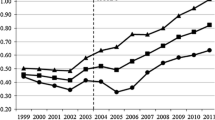Abstract
A prestigious reputation is the primary success factor in higher education because it attracts resources necessary to sustain growth. Among research-intensive universities (RIUs), research performance is a key driver of institutional reputation. Achieving an accelerating rate of growth of research performance is the desired objective of all RIUs which, in turn, is contributing to intensification in the competition for research funds. In competitive environments, the use of strategy is widely used to enhance competitive effectiveness. The question arises as to whether some expressions of strategy are more closely associated with increased research performance than others? This paper provides insight into this question by presenting a model demonstrating that the strategic emphases of individual RIUs in the USA are highly correlated to changes in the shares of federally financed research funding actually realized by the institutions.
Similar content being viewed by others
References
Ansoff, H. I. (assisted by E. J. McDonnell). (1988). New corporate strategy. New York: John Wiley.
Association of American Universities. (2005). Member institutions and years of admission. Retrieved March 28, 2005, from https://doi.org/www.aau.edu
Brewer, D. J., Gates, S. M., & Goldman, C. A. (2002). In pursuit of prestige: Strategy and competition in U.S. higher education. Piscataway, NJ: Transaction Publishers & Rutgers University.
Carnegie Foundation for the Advancement of Teaching. (1987). Classifications. Received by facsimile on March 30, 2005, from Jacki Calvert.
Carnegie Foundation for the Advancement of Teaching. (1994). Classifications. Received by facsimile on March 30, 2005, from Jacki Calvert.
Carnegie Foundation for the Advancement of Teaching. (2000). Classifications. Retrieved March 28, 2005, from https://doi.org/www.carnegiefoundation.org
Carter, R. (1997). Financial analysis for R&D decisions. Society for Research Administration Journal, 29, 1–2, 5.
Clark, B. R. (1992). In T. G. Whiston & R. L. Geiger (Eds.), Research and higher education: The United Kingdom and the United States (Chap. 11). Bristol, PA/Buckingham: Society for Research in Higher Education/Open University Press.
Dill, D. D. (1997). Higher education markets and public policy. Higher Education Policy, 10(3/4), 167–185.
Dill, D. D. (1999). Academic accountability and university adaptation: The architecture of an academic learning organization. Higher Education, 38, 127–154.
Dill, D. D. (2003). Allowing the market to rule: The case of the United States. Higher Education Quarterly, 57(2), 136–157.
Feller, I. (2000). Strategic options to enhance the research competitiveness of EPSCoR universities. In J. S. Hauger & C. McEnaney (Eds.), Strategies for competitiveness in academic research. Retrieved January 12, 2006, from https://doi.org/www.aaas.org
Garvin, D. A. (1980). The economics of university behavior. New York: Academic Press.
Geiger, R. L. (2004). Knowledge and money: Research universities and the paradox of the marketplace. Stanford, CA: Stanford University Press.
Geiger, R. L. (2006). The quest for ‘economic relevance’ by U.S. research universities. Higher Education Policy, 19, 411–431.
Hauger, J. S. (2000). Strategic planning for research competitiveness. In J. S. Hauger & C. McEnaney (Eds.), Strategies for competitiveness in academic research. Retrieved January 12, 2006, from https://doi.org/www.aaas.org
Henderson, B. D. (1972). The experience curve–Reviewed. IV. The growth share matrix or the product portfolio (The Boston Consulting Group, Reprint No. 135). Retrieved March 13, 2008, from https://doi.org/www.bcg.com
Henderson, B. D. (1974). The experience curve–Reviewed. I. The concept (The Boston Consulting Group, Reprint No. 124). Retrieved March 13, 2008, from https://doi.org/www.bcg.com
Hicks, D., & Katz, S. (2008). Excellence and equity: Research performance and resource allocation (Working paper). Retrieved August 8, 2008, from https://doi.org/www.spp.gatech.edu
Johnes, G. (1997). Costs and industrial structure in contemporary British Higher Education. Economic Journal, 107(442), 727–737.
Keller, G. (1983). Academic strategy: The management revolution in American Higher Education. Baltimore, MD: Johns Hopkins University Press.
Lang, D. W. (2004, August). What is a world class university? Paper presented at Beijing Forum.
Litwin, J. (2008). The efficacy of strategy in the competition for research funding in higher education. Doctoral Thesis, University of Toronto, Canada.
Markowitz, H. M. (1990, December 7). Foundations of portfolio theory. Nobel Lecture, Stockholm. Retrieved January 16, 2006, from https://doi.org/www.nobelprize.org
Markowitz, H. M. (1999). The early history of portfolio theory: 1600–1960. Financial Analysts Journal, 55(4), 5–16.
Massy, W. F. (1990). A paradigm for research on higher education. In J. C. Smart (Ed.), Higher education: Handbook of theory and research, 6(1).
McGeary, M., & Smith, P. M. (1996). The R&D portfolio: A concept for allocating science and technology funds. Science, 274, 1484–1485.
Mintzberg, H. (1972). Research on strategy-making. In Proceedings of the 32nd Annual Meeting of the Academy of Management. Minneapolis, MN.
Mintzberg, H. (1994). The rise and fall of strategic planning: Reconceiving roles for planning, plans, planners. New York: Free Press.
Mintzberg, H., Ahlstrand, B., & Lampel, J. (Eds.). (2005). Strategy bites back: It is a lot more, and less, than you ever imagined. London: Prentice-Hall.
Naylor, T. H., & Tapon, F. (1982). The Capital Asset Pricing Model: An evaluation of its potential as a strategic planning tool. Management Science, 28, 1166–1173.
NSF. (2003). FY2003 GPRA revised final performance plan. Retrieved July 31, 2007, from https://doi.org/www.nsf.gov
NSF. (2006). Table 5: Federally financed R&D expenditures at universities and colleges, by science and engineering field: FY1999–2006. Retrieved January 16, 2008, from https://doi.org/www.nsf.gov
Pennsylvania State University. (2004). Office of the Senior Vice President for Research strategic plan FY2009–FY2013. Retrieved April 13, 2006, from https://doi.org/www.research.psu.edu
Porter, M. E. (1996). What is strategy? Harvard Business Review, p. 74.
Research Assessment Exercise. (2008). Units of assessment (UOAs). Retrieved September 27, 2007, from https://doi.org/www.rae.ac.uk
Teixeira, P., Jongbloed, B., Dill, D. D., & Amaral, A. (Eds.). (2004). Markets in higher education: Rhetoric or reality? (Higher Education Dynamics, Vol. 6). Dordrecht, The Netherlands: Kluwer Academic.
University of Glasgow. (2001). RAE 2001 Unit of assessment analysis. Retrieved June 16, 2005, from https://doi.org/www.gla.ac.uk
Zemsky, R. (1997). In search of strategic perspective: A tool for mapping the market in postsecondary education. Change, 29(6), 23–39.
Author information
Authors and Affiliations
Corresponding author
Rights and permissions
About this article
Cite this article
Litwin, J.M. The Efficacy of Strategy in the Competition for Research Funding in Higher Education. Tert Educ Manag 15, 63–77 (2009). https://doi.org/10.1080/13583880802700131
Published:
Issue Date:
DOI: https://doi.org/10.1080/13583880802700131



